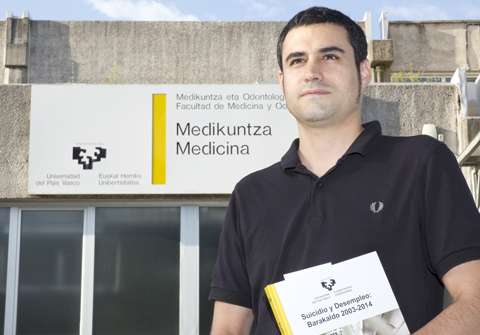Researcher determines populations most at risk of suicide during stressful situations

In an exhaustive study of the evolution in suicide rates in the municipality of Barakaldo during the 2003-2014 period, a UPV/EHU lecturer in psychiatry uncovered the social groups in which there was an increase in the number of suicides after loss of employment. Studies of this type should elevate suicide from a taboo subject and teach people to spot warning signs displayed by people who might be harbouring suicidal thoughts.
Suicide is the result of a complex interaction among a host of factors. "It is worth highlighting clinical factors such as a history of psychiatric and psychosocial disorders, the loss of the social support network, the loss of employment or acute stress," says Jon García-Ormaza, lecturer in psychiatry at the UPV/EHU and medical psychiatrist at University Hospital Cruces. The economic crisis affecting Europe since 2008 has had consequences for two of these aspects. First, it leads to an increase in unemployment, and second, the population has fewer economic resources. "Since that year, in fact, a degree of alarm has begun to spread in public opinion. Information that was not always evidence-based began to emerge saying that there was a clear relationship between the increase in suicides and the economic crisis," explained García-Ormaza.
In order to verify these ideas scientifically, García-Ormaza decided to tackle the study of the register of suicides among the inhabitants in the municipality of Barakaldo across a 12-year period from 2003 to 2014 to study the suicide rate before and after the economic crisis. The year 2008 is the limit or cut-off point, which was when the unemployment rate in Barakaldo shot up. In 2004, the unemployment rate was 9 percent and from 2008 onward, it gradually increased, reaching 20 percent in 2012.
"We saw that there was no statistically significant increase in suicides from 2008 onwards in the general population; the suicide rates were fairly steady, about eight deaths due to suicide per year for every 100,000 inhabitants," said García-Ormaza. Yet when the study is fine-tuned a little more to focus on specific social groups, "we certainly saw differences. Specifically, we saw a statistically significant increase in two subgroups: individuals with a history of psychiatric disorders, and young women of working age (under 65). In the cases belonging to the first group, the main disorders these individuals suffered were addictions (harmful consumption of alcohol and/or other substances), followed by anxiety disorders and depression," he said. "What happens is that these people do not tend to benefit from social assistance, which is found to be protective in serious mental disorders".
In the case of young women, what stands out is that all the cases of suicide were registered in the more socioeconomically disadvantaged districts of Barakaldo.
Prevention is key to averting these events
According to García-Ormaza, the results obtained in this study should serve "to channel the limited resources existing for measures towards preventing suicide wherever they are needed more. And from what we have seen, they are more necessary in the more disadvantaged areas in the case of young women, and also in the case of people with apparently less severe psychiatric disorders such as alcoholism, anxiety and depression."
"But it is also true," he added, "that a third of the people who died as a result of suicide in Barakaldo had no known history of psychiatric problems." This is linked to the conditions of the social environments of these people. The lecturer explained it thus: "A person who considers the idea of suicide may go ahead with it in an impulsive way when faced with a highly stressful life situation."
That is why it is very important to create a network of protection in which people are capable of spotting those at risk. The cornerstones in these cases are the family doctor and the psychiatrist. "According to the WHO, many suicides can be prevented. The main prevention measures include limiting access to lethal methods, treating people who suffer from mental disorders, actively monitoring the people with a history of suicide attempts, encouraging responsible coverage of suicides in the media, and training primary health care professionals to spot it. Whenever a person expresses despair, he/she needs to be referred to a healthcare professional as soon as possible."
More information: This study has, so far, been accepted for two presentations at the 16th European Symposium on Suicide and Suicidal Behaviour, to be held in Oviedo (Spain) in September 2016: one is entitled "Suicide and Unemployment: 2003-2014 Period in Barakaldo, Spain", and the other, "The Area of Residence influences Female Suicide".















